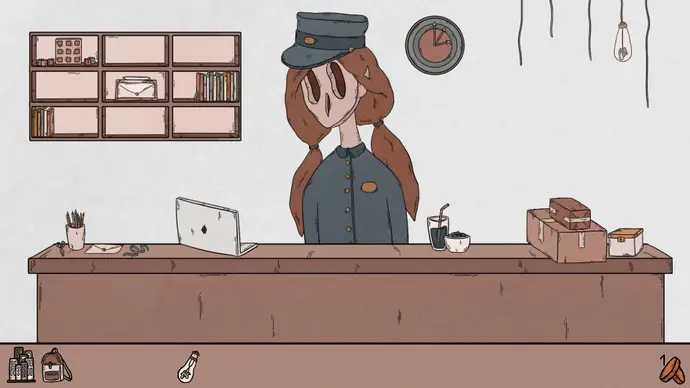
In the latest point-and-click game by Madison Karrh, birth comes after death. Because you’re lonely in the city, you explore the area in search of bones and organs to improvise a temporary companion. If it ever had a little gothic feel to it, it would be a Frankenstein tale. Rather, it’s incredibly superior. It has a peculiar, intimate sensation to it, similar to knowing someone’s daydreams. Birth follows death: this has the twisted logic of daydreams to begin with, a topsy-turvy quality that resonates and finds expression in the way that game elements like feathers, dandelions, pottery pieces, and bird skulls are both worthless and, in the right hands, sort of priceless, and in the way that achieving your ultimate goal is both unachievable and heartbreakingly necessary.
Birth doesn’t say much at all. It’s hand-drawn with bold black lines, a subdued color palette, and a subtle handling of the broken, abandoned, and aged. Teacups empty, clothes quietly swirling in the dryer, old wrists. I suppose it’s a puzzle game, but it’s too deep and thought-provoking to stay in one genre for too long. It serves as a reminder that every game is ultimately just itself, operating inside a single genre. Playing games like Tetris and inventory Tetris, doing jigsaw puzzles, and dominoes are some of the ways you may earn your bones and organs. However, hardly every activity follows such a straightforward logic, and that seems to be a plus. Birth is prepared to go beyond reason and meet you at a more profound level.
You get to assemble a fish tank’s contents and search through a bookcase’s shelves. The actual games you play in Birth always seem to take a backseat to the exploration experience—or maybe prying is a better term—looking through other people’s belongings and penetrating their private lives as though they were an Activity Bear collection. My favorite moment was pressing the keys on an antique manual typewriter, causing plants to sprout from the machine’s chattering internals. The fact that not all manual typewriters behave in this way seems to be an uncommon flaw these days.
Well, that stuff. Birth is created of the items kids would find in their pockets following a productive day in the woods: weeds, buttons, shredded paper scraps, and mushrooms. Since the game is composed of pieces, a common task is to locate and reassemble the various parts of an object. Restoring a thing and getting rewarded with a piece of the live object you eventually aim to repair yourself is kind of like solving a problem inside a puzzle.
These distinct jigsaw pieces are arranged in different sections of a city, shown in the vintage sepia of textbooks, and are faced-on, akin to an Ellen Raskin painting or a New Yorker cover. You may move back and forth between them, stopping at the art studio, the bakery, the library, and so on. The trickiest and most inquisitive of all camera movements, an infinite lateral tracking shot, is what this would be if it were a motion picture. The pages would be thick and the edges would warn against cottony softness if this were a book. Mold starbursts that are reversed might be present.


At the core of the game, there is a quietly magical section where you can explore the hollowed-out bodies of other people, similar to the shucked head of a pomegranate. Or are you giving these folks any favors? Generally speaking, one gets the impression that this place is an unseen power, and occasionally that it is just beneath the surface.
The soundtrack has a somber and eerie feel to it. One rendition of Holst’s I Vow to Thee, My Country sounds as though it was recorded in a haunted storm drain at midnight. A funereal rendering of Beethoven’s Seventh Symphony, which is one of his most melancholic compositions, is being performed in a shopping mall, while bees seem to be buzzing over an organ treatment of the Gymnopedies. I always get the impression that the music is being played somewhere else, that it’s meant for a different audience, and that it’s just leaking through the flimsy walls of a bedsit. As a result, it interacts with your objective, the environment, and the deliberate lack of physical embodiment to produce a game that is starkly absent in a way that is both deep and subtle. This is a game about loneliness, of course—you are creating a friend—but it also understands the icy texture of modern, metropolitan loneliness in a way that astounds me with its compassion and precision.

Where will you go with Birth? I’d be curious to know. Unintentionally, it brought me back to a time more than twenty years ago, when I took a break from university and visited my hometown. Not only did I feel alone as I strolled through the streets, but I also felt invisible—the liberating yet burdensome invisibility of birth—because I realized that no one knew me anymore and that my friends and acquaintances had moved away, just like I had. I was in a land where familiar objects would be the only things to recognize.
It brings me even deeper back, and I believe that’s the point. The clever developer of Birth, Karrh, is also behind several other eerie, thought-provoking, sympathetic games. Maybe this is her strongest, the most nuanced of her questions. Over the course of Birth, you will be asked to sort stones and put bugs back together several times. These are kid-friendly games, and the more I played, the more I started to think that this is an important part of the whole affair. Being alone as an adult hurts much more since it brings up memories of my own loneliness as a youngster. These are those unique, crucial moments when infancy and adulthood collide and we are free to shift between two different ways of being without creating a shadow.